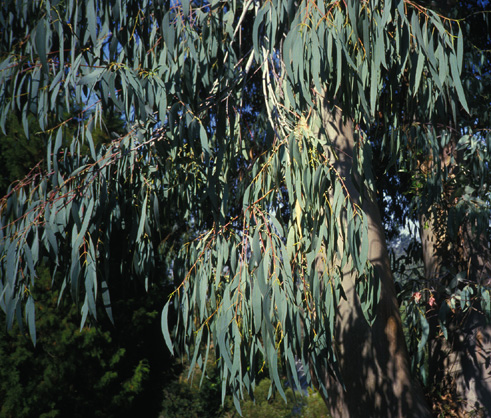
|

|
| Spinning Gum; Eucalyptus Perriniana F. v. Muell. ex Rodway |
Myrtle Family; MYRTACEÆ
|
| To shake-up a staid landscape of prim green bushes and dense pyramidal evergreens, plant a Spinning Gum. All at once, even though small, it attracts attention: people cannot help noticing such vivid powder-blue, round leaves on nodding stems. Dramatically different, like a gong loudly sounding, or the piercing cry of a hawk in the city, it quickens the blood and raises eyebrows. |
| Before going into more detail about this eucalypt in particular, it seems logical to say something about eucalypts in general. There are more than 500 species, nearly all native to Australia. All are evergreen and fragrant. Most grow exceedingly fast, not stopping in winter so much as slowing down. They need sunshine and are usually drought-hardy. Only a hardy handful are unhurt by freezing. |
| Even though few of us have been to Australia, we likely know that a great many eucalypts grow in California. They were first planted there in 1856; some are now even wild. The tallest is over 250 feet! |
| What about Seattle? For years we have planted mostly inappropriate species, or made other blunders with the result that we have few success stories and a long list of failed experiments. However, now that we have studied the trees for years, including some violently harsh winters, we can offer sound advice. If we simply avoid repeating earlier mistakes we can plant eucalypts with confidence that they will not freeze to the roots in the first bad winter. |
| This is where the Spinning Gum comes in. Every large, old eucalypt in Seattle is a Spinning Gum. By old, I mean more than 20 years. Some are over 30 years old. Some are reseeding here. Many snow Gums (Eucalyptus niphophila), Cider Gums (Eucalyptus Gunnii) and a few other kinds have also been planted here in the last several decades, but have not grown as large or proven as enduring as the Spinning Gum. All the evidence suggests Spinning Gum is the most reliable eucalypt for our climate. Other heretofore untested species may match it; time will tell (an extra cold-hardy strain of Eucalyptus pauciflora has proven at least as hardy as the Spinning Gum). |
| In Australia it is called a "mallee" and is bushy, rarely over 30 feet tall. In California and Seattle it ultimately reaches 60 feet tall, 50 feet wide, with a trunk 8 feet around. Its leaves in the seedling stage are large and roundish, and eventually dry to spin around the twigs. But the mature tree makes slender, slightly curved leaves, up to 8.25 inches long and 1.5 inches wide. Puffy white flowers appear in May. The bark peels off the trunk in light brown scrolls. Like all eucalypts here, it is pest and disease free (some Seattle eucalypts suffer minor damage from aphids, powdery mildew and other suchlike trials). |
| The charm of a Spinning Gum in our landscape is its bluish, open airiness, with foliage gently whispering in the wind, infusing fragrance to the air. It enlivens ordinary green gardens and dark houses in a way that the common powder-blue cedars and spruces cannot manage. It is fun to grow something from Australia, especially one that grows so fast and is so showy. |
| Rules for successful planting of eucalypts are: plant while they are small, meaning less than 3 feet tall. Untwist the roots and spread widely. Do not stake. Make sure the tree will get plenty of sunshine. Do not water it, or do so sparingly. Do not fertilize. I say "Don't do this, don't do that" because if you do these things you are likely to cause an unstable tree that grows too fast, then flops over or gets damaged by cold. I know whereof I speak, having made these very errors! |
| Some concern is expressed about a baneful influence cast over the surrounding plants by eucalypts. Witness the lack of undergrowth in Blue Gum (Eucalyptus globulus) plantations of California. Spinning Gums in our area have not demonstrated an obvious " dark shadow" yet, so rest easy on that score. |
| Another concern is size. A Spinning Gum can grow 10 feet tall in the third year after you plant your one-foot tall specimen! You may wonder "Where does this end!?" Even a small garden, however, can contain one at whatever size you prefer, because it is easily pruned, and will readily sprout even from its stump. Cut yours back to the ground periodically if you like. Try growing it as a hedge --we will only find out whether it works by trying. |
At present, Spinning Gums are hard to find in local nurseries. It is easier to purchase less adapted species! It is hoped that a supply of Spinning Gums will be available at the Tilth Edible Landscape Sale in the spring.
|
(Originally published in the March 1990 Seattle Tilth newsletter, along with an illustration by Annie Figliola.)
Back |

